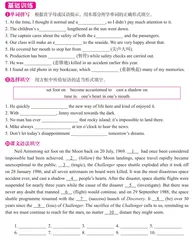Unit 6 Space and beyond

Section Ⅰ Starting out & Understanding ideas
基础训练
单词拼写 根据首字母或汉语提示,用本部分所学单词的正确形式填空。
1. At the time, I thought it normal and u , so I didn’t pay much attention to it.
2. The children’s s lengthened as the sun went down.
3. The captain cares about the safety of both the c and the passengers.
4. Our class will make an e to the seaside. We are very happy about that.
5. He covered her mouth to stop her from (尖声大叫).
6. Production has been (暂停) while safety checks are carried out.
7. He was (悲惨地) killed in an accident earlier this year.
8. I found an old photo in my bookcase, which (重新唤起) many of my memories.
选择填空 用方框中所给短语的适当形式填空。
set foot on become accustomed to cast a shadow on
tune in one’s heart in one’s mouth
1. He quickly the new way of life here and kind of enjoyed it.
2. With , Jenny moved towards the dark.
3. No man has ever that rocky island; it’s impossible to land there.
4. Mike always at ten o’clock to hear the news.
5. Don’t let today’s disappointment tomorrow’s dreams.
课文语法填空
Neil Armstrong set foot on the Moon back on 20 July, 1969. 1 had once been considered impossible had been achieved. 2 (follow) the Moon landings, space travel rapidly became unexceptional to the public. 3 (tragic), the Challenger space shuttle exploded after it took off on 28 January 1986, and all seven astronauts on board were killed. It was the most disastrous space accident ever, and cast a shadow 4 people’s hearts. After the disaster, space shuttle flights were suspended for nearly three years while the cause of the disaster 5 (investigate). But there was never any doubt that manned 6 (flight) would continue, and on 29 September 1988, the space shuttle programme resumed with the 7 (success) launch of Discovery. It 8 (be) over 30 years since the 9 (lose) of Challenger. The sacrifice of the Challenger calls to us, reminding us that we must continue to reach for the stars, no matter 10 distant they might seem.
1. 2. 3. 4. 5.
6. 7. 8. 9. 10.
阅读理解
In about 21 years, it may finally be time to look up. A recently discovered asteroid (小行星) has a chance of hitting the Earth on Valentine’s Day in 2046. It was discovered on 26 February, 2023 at an observatory in San Pedro de Atacama, Chile.
While the thought of an asteroid hitting the earth may sound concerning, NASA says people shouldn’t be worried.
The asteroid has an estimated diameter of 160 feet, which is about the same size as an Olympic swimming pool or the width of a football field.
“We’ve been tracking a new asteroid named 2023 DW that has a very small chance of impacting the Earth. Often when new objects are discovered, it takes several weeks’ data to reduce the uncertainties and adequately (足够地) predict their orbits years into the future,” NASA’s Planetary Defense Coordination Office (PDCO) said.
The asteroid is ranked on the Torino Scale as Level 1 threat. The scale is a tool to categorize potential Earth impacts, with zero being no threat and 10 being something that can cause a global disaster. One on the Torino Scale means 2023 DW is in the normal, or green zone.
“Current calculations show the chance of collision (碰撞) is extremely unlikely with no need for public concern,” NASA says of the green zone. “New telescopic observations will very likely lead to re-assignment to Level 0.”
Although 2023 DW doesn’t pose a great risk to the Earth, NASA has been continuing to work to defend our planet from any asteroid that could cause disaster.
In September, 2022, NASA crashed its Double Asteroid Redirection Test spacecraft, or DART, into an asteroid to see if it could change the trajectory of the space rock. NASA later confirmed the mission was a success, and is continuing to research how effective the method is, should a massive asteroid be headed our way.
1. What did NASA’s PDCO say about 2023 DW?
A. It is too close to the Earth. B. It must be destroyed in space.
C. Its orbit is still uncertain now. D. Its orbit should be changed.
2. How is 2023 DW ranked on the Torino Scale?
A. As Level zero threat. B. As Level ten threat.
C. In the normal zone. D. In the threatening zone.
3. What does the underlined word “trajectory” mean in the last paragraph?
A. Size. B. Weight. C. Angle. D. Path.
4. What can be a suitable title for the text?
A. An Asteroid Was Discovered at an Observatory in Chile
B. An Asteroid Is Coming Our Way, Unlikely to Hit Us
C. A Space Rock Has Just Passed the Earth
D. A Spacecraft Has Been Crashed Recently
阅读七选五
In 1969, when Neil Armstrong first landed on the Moon, many people thought soon we would be regularly visiting other planets. 1 The reality is that space exploration is extremely difficult and dangerous. Some people believe it is a waste of the public purse and does nothing to improve our lives. Why do we continue to explore space, then?